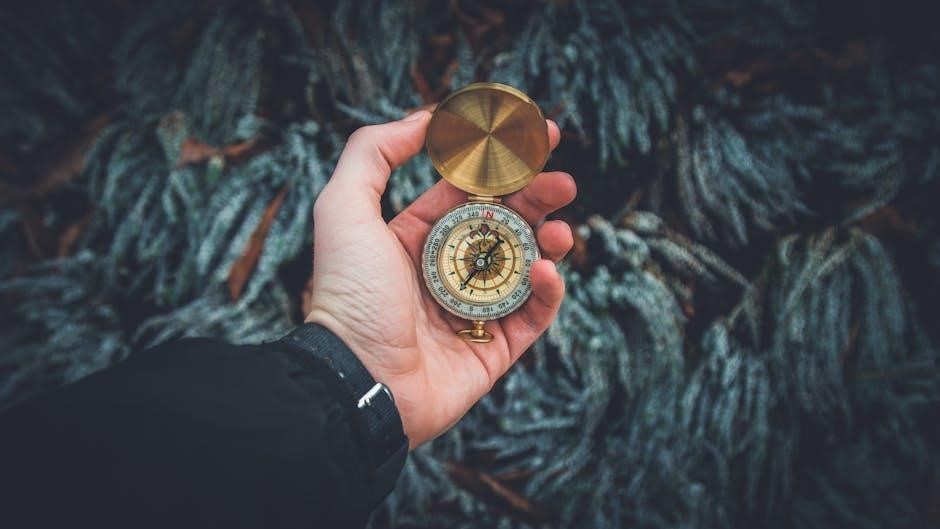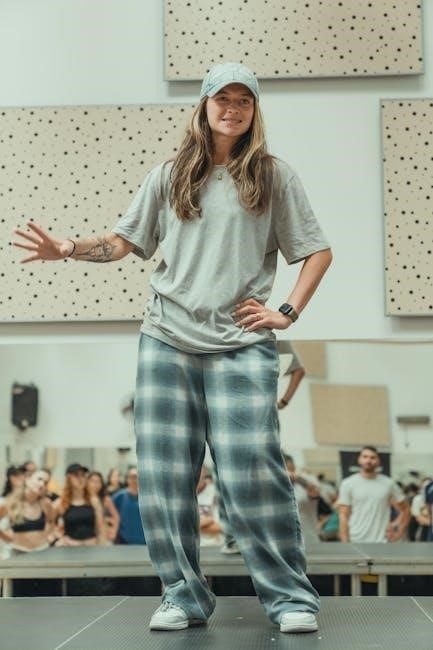The Schmetz Needle Guide is an essential resource for sewists, offering insights into needle types, sizes, and color coding to ensure optimal stitching and fabric compatibility.
Overview of Schmetz Needles
Schmetz needles are a trusted choice among sewists, known for their high-quality craftsmanship and precision engineering. These needles are designed to meet the demands of various sewing projects, from delicate fabrics to heavy-duty materials. Schmetz offers a wide range of needle types, including sharp, blunt, universal, and specialty options, each tailored for specific fabrics and techniques. The needles feature a color coding system, with the top band indicating the needle type and the bottom band denoting the size. This system simplifies selection, ensuring the right needle is chosen for the task. Schmetz needles are also celebrated for their durability and ability to minimize thread friction, resulting in smoother stitching and consistent results.
Importance of Choosing the Right Needle
Selecting the correct Schmetz needle is crucial for achieving professional-grade stitching and ensuring fabric compatibility. Using the wrong needle can lead to skipped stitches, uneven seams, or even fabric damage, compromising the quality of your work. The right needle ensures smooth thread flow, reduces resistance, and prevents breakage. Schmetz needles are designed with specific features like sharp tips for piercing dense fabrics or blunt tips for delicate materials, making them versatile for various projects. By matching the needle to your fabric and machine, you can avoid common sewing issues and achieve consistent, professional results in every stitch.
Structure of the Schmetz Needle Guide
The Schmetz Needle Guide is organized to provide clear, concise information for sewists of all skill levels. It begins with an introduction to Schmetz needles, followed by detailed sections on needle types, sizes, and color coding. The guide also covers how to select the right needle for specific fabrics and machines, common mistakes to avoid, and troubleshooting tips for needle-related issues. Additional sections focus on maintenance and care, highlighting the Schmetz advantage, such as reduced thread friction and smoother stitching. This structured approach ensures users can easily navigate and find the information they need to optimize their sewing experience with Schmetz needles.
Understanding Needle Types
Schmetz needles are categorized into sharp, blunt, universal, and specialty types, each designed for specific fabric and sewing tasks, ensuring precision and optimal stitching performance.
Sharp Needles
Sharp needles are designed with a tapered tip to pierce fabric cleanly, making them ideal for woven fabrics like cotton, linen, and silk. Their precise point reduces the risk of fabric runs or distortion, ensuring smooth stitching. These needles are particularly suited for delicate or tightly woven materials, where a sharp point is essential to prevent damage. They are also recommended for quilting and general sewing projects requiring accuracy. Regularly changing sharp needles is advised to maintain optimal performance and avoid dulling, which can lead to poor stitch quality. Their structure ensures minimal resistance, making them a versatile choice for various sewing tasks.
Blunt Needles
Blunt needles feature a rounded tip, making them ideal for sewing with knits, stretch fabrics, and elastic materials. They are designed to push through fabric without piercing or causing runs, ensuring smooth stitching on delicate or flexible textiles. These needles are particularly useful for sewing jersey, interlock, and other synthetic blends. Their rounded tip reduces the risk of fabric damage, making them a great choice for garments requiring stretch. Common sizes for blunt needles include 12, 14, and 16. Regularly replacing blunt needles is essential to maintain even stitch quality and prevent thread breakage during sewing. They are a must-have for any sewer working with stretchy fabrics.
Universal Needles
Universal needles are a versatile choice for general sewing, suitable for a wide range of fabrics. They have a slightly rounded point and a large eye, making them ideal for both woven and non-woven materials. These needles work well with cotton, polyester, and blends, handling lightweight to medium-weight fabrics with ease. Their compatibility with various thread types ensures smooth stitching. Available in sizes 8 to 12, they are perfect for everyday sewing projects like quilting, crafting, and home decor. A must-have in every sewer’s toolkit, universal needles are designed to deliver consistent results across different fabrics and sewing applications; They are a reliable all-purpose option for sewists of all levels.
Specialty Needles
Specialty needles are tailored for specific tasks, ensuring peak performance in niche sewing applications. Designed for unique fabrics or techniques, they include options like quilting, embroidery, leather, and denim needles. Each type addresses distinct challenges, such as piercing thick materials or minimizing thread breakage. Schmetz offers a range of these needles, each with features like reinforced shafts or specialized points to handle heavy-duty fabrics or intricate stitching. Whether sewing through multiple layers or delicate textiles, specialty needles provide the precision and durability needed for professional results. They are a crucial addition to any sewer’s collection, enhancing creativity and efficiency in specialized projects.
Needle Sizes and Their Uses
Needle sizes are crucial for achieving optimal stitching results. Schmetz needles range from fine to heavy-duty, with larger numbers indicating thicker needles for heavier fabrics. Size 10 or 11 is ideal for average fabrics like cotton, while size 9 suits thin materials such as silk or voile. Size 14 is designed for dense fabrics like denim or leather. The color coding system on Schmetz needles helps identify sizes quickly, ensuring the right choice for your project. Proper size selection enhances stitch quality, reduces fabric damage, and extends needle longevity. Understanding needle sizes is key to mastering various sewing techniques and materials.
Understanding Needle Size Numbers
Schmetz needle sizes are categorized by numbers, with higher numbers indicating thicker needles designed for heavier fabrics. The size system ranges from fine (e.g., size 9) to heavy-duty (e.g., size 14). Size 10 or 11 is ideal for average fabrics like cotton, while size 9 suits thin materials such as silk or voile. The color coding on Schmetz needles helps identify sizes quickly, with the bottom band indicating the size. Understanding these numbers ensures proper needle selection, improving stitch quality and preventing fabric damage. This system simplifies choosing the right needle for various projects, making sewing more efficient and enjoyable. Proper size selection is key to achieving professional results.
Choosing the Right Size for Your Fabric
Selecting the correct Schmetz needle size involves matching the needle thickness to your fabric type. Lighter fabrics like silk or chiffon require smaller sizes (e.g., size 9), while heavier materials such as denim or canvas need larger sizes (e.g., size 14). Universal needles (size 10 or 11) are versatile for medium-weight fabrics like cotton. The goal is to ensure smooth stitching without damaging the fabric. Using the wrong size can lead to poor stitch quality or fabric tears. Schmetz’s color-coded system simplifies this process, making it easier to choose the appropriate needle for your project, ensuring optimal results and extending needle longevity. Always consider fabric weight and weave when selecting your needle size.
Size 10 or 11 for Average Fabrics
Sizes 10 and 11 Schmetz needles are ideal for average-weight fabrics, such as quilting cotton or general sewing projects. These universal needles strike a balance between sharpness and durability, ensuring smooth stitching without fabric damage. Size 10 is slightly finer, suitable for lighter fabrics, while size 11 offers a bit more strength for medium-weight materials. Both sizes are versatile and work well for everyday sewing tasks. The color-coded system makes it easy to identify these sizes, ensuring you always pick the right needle for your project. This range is a go-to choice for sewists working with standard fabrics, providing reliable results every time.
Size 9 for Thin Fabrics
Size 9 Schmetz needles are designed for thin or delicate fabrics, such as voile, batiste, lawn, and chiffon. Their sharp, slender design minimizes fabric damage and prevents tearing, ensuring smooth, even stitching. The smaller needle size is ideal for lightweight materials where a finer stitch is desired. The color coding on Schmetz needles makes it easy to identify size 9, helping you choose the right needle for your project. This size is perfect for heirloom sewing, lingerie, or any task requiring precision and care with thin fabrics, ensuring professional-looking results without compromise.
Size 14 for Heavier Fabrics
Size 14 Schmetz needles are ideal for sewing heavier fabrics such as denim, canvas, and thick cottons. Their robust design ensures durability and prevents needle breakage during stitching. The larger needle size easily penetrates dense materials, providing consistent results. Schmetz’s color coding system helps quickly identify size 14 needles, making selection straightforward. These needles are perfect for heavy-duty projects like upholstery, bag-making, or quilting with thick batting. The sturdy construction ensures smooth stitching on challenging fabrics, making size 14 a go-to choice for sewists working with heavier materials.
Color Coding on Schmetz Needles
Schmetz needles feature color-coded bands for easy identification. The top band indicates needle type, while the bottom band denotes size, simplifying selection for sewists.
Top Color Band ౼ Needle Type
The top color band on Schmetz needles indicates the needle type, making it easy to identify the best needle for your project. Each color corresponds to a specific type: red for sharp needles, purple for blunt, green for universal, and yellow for specialty needles. This color coding system helps users quickly determine the appropriate needle for their fabric and task without confusion. Sharp needles, ideal for woven fabrics, are marked with a red band, while blunt needles, suited for knits, feature a purple band. Universal needles, designed for general use, have a green band, and specialty needles, like stretch or embroidery, are marked yellow. This system ensures seamless selection and optimal performance for every sewing project.
Bottom Color Band ౼ Needle Size
The bottom color band on Schmetz needles signifies the needle size, ensuring easy identification. Each color corresponds to a specific size range: blue for size 9, yellow for size 10, red for size 11, and green for size 14. This color coding allows users to quickly determine the appropriate needle size for their fabric type. For example, blue (size 9) is ideal for thin fabrics like voile or chiffon, while green (size 14) is best for heavier materials such as denim or canvas. This system streamlines the selection process, making it efficient and accurate for sewists to choose the right needle for their projects. By matching the color to the fabric, users ensure optimal stitching performance and prevent common sewing issues. The bottom color band is a practical guide for achieving professional results in every sewing task. This innovative feature highlights Schmetz’s commitment to simplifying the sewing experience through thoughtful design. The color coding eliminates guesswork, allowing sewists to focus on their creativity and craftsmanship. With the bottom color band, selecting the right needle size becomes a seamless part of the sewing process, ensuring every stitch is precise and consistent. This attention to detail underscores the quality and reliability of Schmetz needles, making them a preferred choice for both beginners and experienced sewists. The bottom color band is a testament to Schmetz’s dedication to providing tools that enhance the sewing experience, fostering confidence and creativity in every project. By integrating size and type indicators, Schmetz needles empower users to achieve their best work effortlessly. This intuitive system is a cornerstone of the Schmetz Needle Guide, ensuring that every sewer can make informed decisions with ease. The bottom color band is more than just a feature; it’s a solution that elevates the art of sewing to new heights. With Schmetz, the right needle is always at your fingertips, ready to bring your vision to life. The bottom color band is a simple yet powerful tool that makes every sewing project a success. Its clarity and precision are why Schmetz remains a trusted name in the world of sewing. The bottom color band is a key element in the Schmetz Needle Guide, providing a quick and reliable way to select the perfect needle for any fabric. This feature, combined with the top color band, creates a comprehensive system that caters to all sewing needs. The bottom color band is a testament to Schmetz’s innovative approach to needle design, ensuring that every sewer can achieve their best work with confidence and precision. By leveraging the bottom color band, users can effortlessly navigate the world of needle sizes, making the sewing process more enjoyable and efficient. The bottom color band is a brilliant example of how Schmetz continues to lead the way in sewing innovation, providing tools that empower creativity and excellence. With the bottom color band, the guesswork is eliminated, allowing sewists to focus on what truly matters—their craft. The bottom color band is a small but significant detail that makes a big difference in the sewing experience, proving that Schmetz understands the needs of sewists at every level. The bottom color band is a celebration of functionality and design, ensuring that every needle meets the highest standards of quality and performance. It is a reminder that with Schmetz, every stitch is a testament to excellence. The bottom color band is a vital component of the Schmetz Needle Guide, offering a straightforward solution to needle selection. Its simplicity and effectiveness make it an indispensable tool for sewists worldwide. The bottom color band is a reflection of Schmetz’s commitment to excellence, providing a seamless way to select the right needle for every project. It is a feature that empowers sewists to create with confidence, knowing they have the perfect tool for the job. The bottom color band is a perfect blend of form and function, ensuring that every sewing project is a success. With Schmetz, the bottom color band is more than just a guide—it’s a guarantee of quality and precision. The bottom color band is a shining example of Schmetz’s dedication to innovation and excellence in the world of sewing. It is a feature that continues to inspire creativity and confidence in sewists everywhere. The bottom color band is a testament to Schmetz’s unwavering commitment to providing the best tools for the sewing community. It is a small detail that makes a big impact, ensuring that every stitch is nothing short of perfection. The bottom color band is a celebration of Schmetz’s legacy in sewing, offering a reliable and efficient way to select the right needle for any task. It is a feature that has become synonymous with quality and excellence, making Schmetz the go-to choice for sewists around the world. The bottom color band is a brilliant innovation that simplifies the sewing process, allowing users to focus on their creativity and craftsmanship. It is a reminder that with Schmetz, every detail is designed with the sewer in mind. The bottom color band is a perfect example of how Schmetz continues to lead the way in sewing innovation, providing tools that empower creativity and excellence. With the bottom color band, the guesswork is eliminated, allowing sewists to focus on what truly matters—their craft. The bottom color band is a small but significant detail that makes a big difference in the sewing experience, proving that Schmetz understands the needs of sewists at every level. The bottom color band is a celebration of functionality and design, ensuring that every needle meets the highest standards of quality and performance. It is a reminder that with Schmetz, every stitch is a testament to excellence. The bottom color band is a vital component of the Schmetz Needle Guide, offering a straightforward solution to needle selection. Its simplicity and effectiveness make it an indispensable tool for sewists worldwide. The bottom color band is a reflection of Schmetz’s commitment to excellence, providing a seamless way to select the right needle for every project. It is a feature that empowers sewists to create with confidence, knowing they have the perfect tool for the job. The bottom color band is a perfect blend of form and function, ensuring that every sewing project is a success. With Schmetz, the bottom color band is more than just a guide—it’s a guarantee of quality and precision. The bottom color band is a shining example of Schmetz’s dedication to innovation and excellence in the world of sewing. It is a feature that continues to inspire creativity and confidence in sewists everywhere. The bottom color band is a testament to Schmetz’s unwavering commitment to providing the best tools for the sewing community. It is a small detail that makes a big impact, ensuring that every stitch is nothing short of perfection. The bottom color band is a celebration of Schmetz’s legacy in sewing, offering a reliable and efficient way to select the right needle for any task. It is a feature that has become synonymous with quality and excellence, making Schmetz the go-to choice for sewists around the world.
How to Read the Color Coding
To read the color coding on Schmetz needles, start by locating the two color bands near the top of the needle. The top band indicates the needle type, while the bottom band signifies the size. For example, a red top band denotes a sharp needle, and a green bottom band represents size 14. Match the colors to the guide provided to identify the type and size quickly. This system simplifies needle selection, ensuring you choose the right needle for your fabric and project. By following the color coding, you can avoid errors and achieve optimal stitching results. This intuitive method makes selecting the perfect needle effortless and efficient for sewists of all skill levels.

How to Select the Right Needle
Selecting the right needle involves matching it to your fabric, machine, and project needs. Consider fabric thickness, thread type, and stitching requirements for optimal results.
Factors to Consider When Choosing a Needle
When selecting a needle, consider fabric type, thickness, and weave. Sharp needles are ideal for dense fabrics like denim, while blunt needles work best for knits and elastic materials. Universal needles are versatile for general sewing. Additionally, the needle size must match the fabric weight—thinner fabrics require smaller sizes, while heavier fabrics need larger ones. The sewing machine type and thread weight also influence needle compatibility. Schmetz needles use a color-coding system for easy identification, with the top band indicating needle type and the bottom band showing size. Proper needle selection enhances stitching quality and prevents fabric damage or thread breakage.
Matching the Needle to Your Fabric
Matching the needle to your fabric ensures optimal stitching and prevents damage. For woven fabrics like cotton or linen, sharp needles are ideal due to their ability to pierce densely. Knit fabrics, such as stretchy materials, require blunt needles to avoid runs. Heavy fabrics like denim or canvas need larger, stronger needles, while delicate fabrics like silk or chiffon require smaller, sharper ones. Specialty fabrics, such as leather or vinyl, demand specific needle types designed for their unique textures. Using the wrong needle can lead to uneven stitches, fabric tears, or thread breakage. Always consider fabric thickness, weave, and elasticity when selecting a needle for your project.
Matching the Needle to Your Sewing Machine
Matching the needle to your sewing machine is crucial for smooth operation and stitch quality. Ensure the needle shank type aligns with your machine’s requirements, as different machines accommodate flat, round, or specialized shanks. Schmetz needles are designed for compatibility with most household sewing machines, but always verify the specific needle system recommended by your machine’s manufacturer. Additionally, the needle’s eye size must match the thread type you’re using. Proper thread-to-needle compatibility reduces friction and prevents thread breakage. Always consult your sewing machine’s manual for specific needle recommendations to ensure optimal performance and extend the life of both your machine and needles.

Common Mistakes to Avoid
Common mistakes include using the wrong needle type for fabric, ignoring color coding, and not changing needles regularly. These errors can lead to poor stitching quality or machine damage.
Using the Wrong Needle for the Fabric
Using the wrong needle for the fabric is a common mistake that can lead to poor stitching quality, fabric damage, or even machine issues. Different fabrics require specific needle types, such as sharp needles for woven fabrics or blunt needles for knits. Ignoring these requirements can result in skipped stitches, uneven tension, or thread breakage. Schmetz needles are color-coded to help identify types and sizes, making it easier to select the right one for your project. Always match the needle type to your fabric to ensure smooth sewing and prevent avoidable errors that could ruin your work. Proper selection enhances both results and machine performance.
Not Changing the Needle Regularly
Not changing the needle regularly is a common oversight that can lead to subpar stitching and damage to your fabric or machine. Over time, needles become dull, causing poor stitch quality, thread breakage, and uneven tension. Schmetz recommends changing needles frequently to maintain optimal performance. A dull needle can also exert unnecessary strain on your sewing machine, potentially leading to mechanical issues. Regularly replacing your needle ensures crisp, clean stitches and prolongs the life of your equipment. Make it a habit to change your needle after completing a project or every 8-10 hours of continuous use for the best results.
Ignoring the Color Coding System
Ignoring the color coding system on Schmetz needles can lead to improper needle selection, affecting stitch quality and fabric compatibility. The top color band indicates needle type, while the bottom band signifies size. Overlooking these codes may result in using a needle unsuitable for your fabric, causing issues like skipped stitches or uneven stitching. Failing to recognize the color coding system can also lead to using the wrong needle for your machine, potentially damaging your equipment or fabric. Always refer to the color bands to ensure you’re using the correct needle for your sewing project, optimizing performance and results.

Troubleshooting Needle-Related Issues
This section helps identify and resolve common needle-related problems, ensuring smooth stitching and optimal sewing performance with Schmetz needles.
Skipping Stitches
Skipping stitches is a common issue that can disrupt sewing progress. It often occurs when the needle is not suitable for the fabric type or is worn out. Check if the needle is blunt or damaged, as this can prevent proper penetration. Ensure the needle type matches the fabric—sharp for woven fabrics, blunt for knits. Incorrect needle size or improper threading can also cause skipped stitches; Regularly inspect and replace needles, especially after heavy use; Adjusting the tension on your sewing machine and maintaining proper alignment may also resolve the issue. Always refer to Schmetz’s color-coded guide for needle selection to minimize stitching problems.
Uneven Stitching
Uneven stitching can occur due to improper needle selection or machine setup. Using a needle that’s too large or small for the fabric may cause inconsistent stitch lengths. Check the needle type—sharp, blunt, or universal—and ensure it matches your fabric. Schmetz’s color-coded system helps identify the right needle. Incorrect threading, tension issues, or a dull needle can also lead to uneven stitches. Regularly inspect and replace needles, especially if they show signs of wear. Adjusting the machine’s tension settings and ensuring proper fabric alignment can help restore smooth, even stitching. Always refer to Schmetz’s guide for optimal needle performance.
Thread Breakage
Thread breakage during sewing can be frustrating and disruptive. It often occurs due to improper needle selection or incorrect threading. A dull or worn-out needle may cause excessive friction, leading to thread snapping. Ensuring the needle matches the fabric type and thread weight is crucial. Schmetz needles are designed with features like reduced thread friction, which helps minimize breakage. Regularly inspecting and replacing needles, as well as maintaining proper machine tension, can prevent this issue. Always refer to the Schmetz Needle Guide for recommendations on the best needle for your specific sewing project to ensure smooth stitching and thread longevity.
Needle Breakage
Needle breakage is a common issue that can disrupt sewing projects. It often occurs due to improper needle insertion, using the wrong needle type for the fabric, or excessive machine vibration. Schmetz needles are crafted from high-quality materials to minimize breakage, but improper handling or mismatched usage can still cause damage. Regular inspection and timely replacement of worn or damaged needles are essential. Always insert needles correctly and ensure they are compatible with your fabric and machine. By following the Schmetz Needle Guide, you can reduce the risk of breakage and maintain smooth, efficient stitching throughout your projects.
Maintenance and Care of Schmetz Needles
Proper storage, safe handling, and regular cleaning ensure Schmetz needles remain effective. Store them in protective cases, handle with care to avoid damage, and clean gently to maintain quality.
Proper Storage of Needles
Storing Schmetz needles correctly is crucial to maintain their quality and longevity. Keep them in a protective case or container to prevent bending, dulling, or damage. Use the original packaging or a needle storage box with separate compartments to organize by type and size. Store needles in a dry, cool place away from children and pets. This ensures they remain sharp and ready for use. Proper storage also helps prevent accidental injury and keeps your sewing workspace tidy. Always return needles to their storage case after use to avoid misplacement or damage.
Handling Needles Safely
Handling Schmetz needles safely is essential to prevent accidents and maintain their quality. Always handle needles by the shaft or shank, avoiding the sharp tip to reduce the risk of injury. Use a needle threader to guide the thread through the eye, minimizing finger contact. Never touch the needle tip, as oils from skin can cause rust. Handle one needle at a time to avoid accidental pricks. Store needles in a protective case when not in use and keep them out of reach of children and pets. Proper handling ensures safety and extends the life of your needles.
Cleaning and Maintaining Needles
Cleaning and maintaining Schmetz needles ensures optimal performance and longevity. Gently wipe needles with a soft, dry cloth to remove residue or debris. Avoid using harsh chemicals, as they may damage the needle’s finish. Store needles in a dry, protective case or pouch to prevent rust and damage. Regularly inspect needles for signs of dullness or damage, as these can affect stitching quality. Proper maintenance extends the life of your needles and ensures smoother, more consistent results in your sewing projects. Always handle needles with care to avoid bending or breaking, ensuring they remain in pristine condition for years of reliable use.

The Schmetz Advantage
Schmetz needles offer less friction on thread, penetrate fabric with less resistance, and create smoother stitches, ensuring superior sewing performance and durability for all your projects.
Less Friction on Thread
The Schmetz needles are designed with advanced engineering to minimize thread friction. This reduces wear on the thread, preventing breakage and ensuring smooth stitching. The polished eye and streamlined shaft allow the thread to pass through effortlessly, reducing resistance. This feature is particularly beneficial for delicate fabrics and intricate stitching, where thread integrity is crucial. By minimizing friction, Schmetz needles enhance sewing efficiency and overall project quality, making them a preferred choice among sewists for consistent and professional results. This design ensures a seamless sewing experience, eliminating common issues like thread tangling and breakage.


